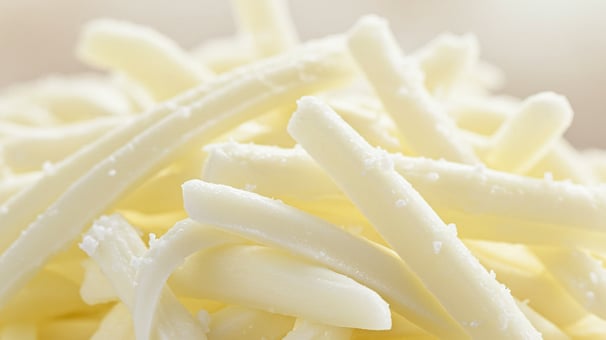FrieslandCampina’s Innovation in High-Moisture Mozzarella Cheese
DAIRY & ALTERNATIVES SUSTAINABILITY


This is an AI generated illustration and does not represent actual product or service.
In the world of cheesemaking, mozzarella holds a special place as a versatile, beloved cheese known for its smooth, elastic texture and excellent melting properties. FrieslandCampina, a global leader in dairy innovation, has recently filed a patent application on a novel process for producing high-moisture mozzarella cheese with an elevated calcium-to-protein ratio. This innovation not only enhances the cheese’s melting and baking properties but also boosts its nutritional value, making it an ideal choice for applications like pizza cheese.
The Challenge with Traditional Mozzarella
Mozzarella cheese is traditionally made through a process known as pasta filata, which involves heating and stretching curd to create its characteristic texture. While mozzarella is widely used in cooking, particularly in baking applications like pizza, it often faces limitations when it comes to moisture content and calcium retention.
- Moisture Content: Most mozzarella cheeses have a moisture content of up to 50% by weight. While higher moisture levels (above 50%) improve melting properties and reduce browning and blistering during baking, they also make the cheese softer and more difficult to shred, cut, or grate.
- Calcium Retention: Calcium is a crucial mineral for human health, supporting bone health, muscle function, and nerve regulation. However, traditional cheesemaking processes often result in calcium loss, reducing the cheese’s nutritional value. Additionally, higher calcium content increases the cheese’s firmness, which is beneficial for processing but can make it harder to achieve high moisture levels.
FrieslandCampina’s patent addresses these challenges by introducing a novel process that produces high-moisture mozzarella cheese with a high calcium-to-protein ratio, combining the best of both worlds: excellent baking performance and enhanced nutritional benefits.
The Innovation: A Simple Yet Effective Process
The patented process involves immersing comminuted (shredded, grated, or diced) mozzarella cheese in a liquid medium under specific conditions to increase its moisture content while retaining calcium. The key steps of the process are as follows:
1. Providing Mozzarella Cheese: Start with mozzarella cheese having a moisture content below 50% by weight.
2. Comminuting the Cheese: Shred, grate, or dice the cheese into small particles.
3. Immersion in Liquid Medium: Immerse the comminuted cheese in a liquid medium (water or an aqueous solution) at a temperature between -2°C and the Moisture Equilibrium Temperature (MET) for at least 10 seconds.
4. Isolation: Remove the cheese from the liquid medium and dry it to obtain high-moisture mozzarella cheese.
Key Features of the Process:
- Moisture Equilibrium Temperature (MET): The MET is the temperature at which the cheese no longer absorbs liquid medium. It varies depending on the cheese’s age and the size of the cheese particles. By immersing the cheese at temperatures below the MET, the process ensures optimal moisture uptake without compromising the cheese’s structure.
- Liquid Medium: The liquid medium can be pure water or an aqueous solution containing preservation acids (e.g., citric acid, lactic acid) or mineral salts (e.g., sodium chloride, calcium chloride). These additives help stabilize the cheese and enhance its flavor.
- Immersion Time: The cheese is immersed for a short duration (10 seconds to 15 minutes), making the process efficient and suitable for industrial production.
Advantages of the High-Moisture Mozzarella
The resulting high-moisture mozzarella cheese offers several key benefits:
1. Enhanced Melting Properties: The increased moisture content (51-65% by weight) improves the cheese’s melting behavior, making it ideal for baking applications like pizza. The cheese melts evenly, with minimal browning and blistering.
2. High Calcium Content: The cheese retains a high calcium-to-protein ratio (at least 28.5 mg/g), providing nutritional benefits while maintaining firmness for easy shredding and grating.
3. Improved Texture: The cheese has a tender, smooth texture that enhances its sensory appeal in both baked and cold applications.
4. Versatility: The cheese can be used in a variety of culinary applications, from pizzas and pasta dishes to salads and sandwiches.
Applications in the Food Industry
FrieslandCampina’s high-moisture mozzarella cheese is particularly well-suited for:
- Pizza Cheese: The cheese’s excellent melting properties and high moisture content make it a superior choice for pizza toppings.
- Ready-to-Eat Meals: The cheese can be used in frozen meals, where its stability and texture are crucial.
- Salads and Cold Dishes: The cheese’s tender texture and rich flavor enhance salads and other cold dishes.
The patent-pending process is not only effective but also efficient, making it suitable for large-scale industrial production. The short immersion time (10 seconds to 15 minutes) minimizes production time, reducing costs and increasing output. Additionally, the process retains calcium, enhancing the cheese’s nutritional value and aligning with consumer demand for healthier food options.


